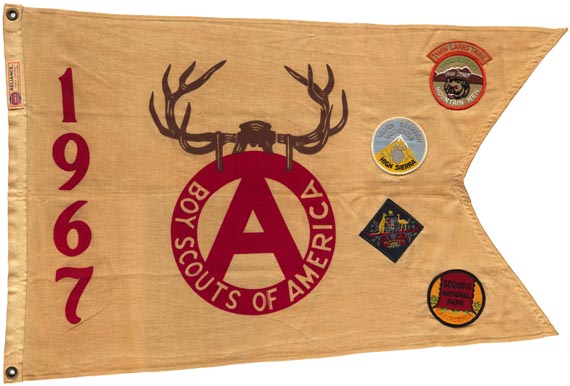continued
CLICK ON ANY IMAGE BELOW TO ENLARGE IT
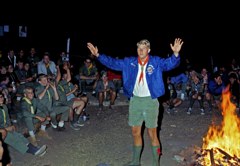 A CAMPFIRE IN 1966 A CAMPFIRE IN 1966 |
Full Program Summer Camp
1946 to 1975
|
As soon as Alden Barber and John Ehrlichman returned from service with the Army Air Corps, Alden proposed a “shuttle service” for pack trips between Wolverton, on the west side of the Sierra, and Lone Pine, on the east side. Each trip included a Mt. Whitney climb. John agreed to the proposal and they made four trips in 1946.
For each trip, Alden brought a truck load of Scouts to Wolverton, rented a mule and a horse (in case of injury or illness), and hit the High Sierra Trail for Mt. Whitney and Lone Pine. Meanwhile, John led a group in the opposite direction. The exchange of questions and answers as the two groups met half-way was something to witness. The trips were successful, in spite of near lightning strikes, altitude sickness, and a severe case of pink eye. In 1947, the “shuttle service” ended as the full program in camp was enhanced.
The Camp was definitely open for business again in the summer of 1946. The actual name “Camp Wolverton” first appeared on the 1946 patch. Actually they were called badges in those days. That year was also the first time the new bear head totem was used for the Camp. This bear was known as the “Hamms Bear” because of his similarity to the bear used to advertise Hamms Beer. All four of the camps in the Crescent Bay Area Council had a cartoon character totem during the late 1940’s and the 1950’s.
The 1954 Camp Director was Art Schlumbohm. He was a new executive to the Crescent Bay Area Council with 20 or 30 years of experience from other councils. Jack Bloch was his assistant director. They ran four full sessions that summer and they wrote an excellent End of Summer Report. Their report stated that attendance at the Camp was up for the third year in a row. There was a mention of the camp fire story about the Indian with the wooden idols. That’s right - it sounds like they had Baby Doll and were telling the story of Chief Crazy Feather as far back as 1954! Their report gave praise to the jobs performed by the Camp Staff, but said it was a young staff that could benefit from better training and better pay. They said they would have better retention of staff from year to year if the pay was higher.
John Squires, who now lives in Sacramento and previously worked for the California Department of Water Resources with Frank Glick, attended summer camp at Wolverton in 1958. He was thirteen years old at the time. He was a First Class Scout in the Eagle Patrol, and the bugler in Troop 850 from Manhattan Beach, California. The trip was led by the Scoutmaster, Mr. Conn. Transportation to and from the camp was in a charted bus.
After arriving at Wolverton, one of the first tasks was setting up his campsite. John remembers looking for a flat spot for his floorless, A-framed pup tent, but all the good spots were taken by the older boys. Late in the first night, a tent set up in one of the “good spots” he didn’t get was ransacked by a bear.
For the next couple of days, John and his Troop spent most of their time exploring the wonders of the Park, such as hiking to the Sherman Tree and to Tharp’s Log. There was also swimming and fishing in Wolverton pond (it reportedly didn’t really silt in until a major summer thunderstorm in the mid or late 1960’s.)
Meals were prepared by a camp cook and all the troops in camp, as well as the staff and camp guests, ate together in the outdoor dinning area. Great campfires were held in the evenings. An Order of the Arrow tap-out and Ordeal was held that week.
In the middle of the week, a staff man led the Troop up to a backcountry lake. John says that a burro carried the food and cooking gear, but he had to carry his own sleeping bag and personal equipment. Burros continued carrying the group gear until 1971 when either expense or burro availability made it impossible.
Back at Wolverton after being in the backcountry, hot showers were had by all. A camp rodeo full of games and events highlighted the end of the week. John earned and still has the “1958 Good Camper” segment to go under the camp patch. In 1998, 40 years later, at the time John was interviewed by his co-worker Frank, the fun memories of Camp Wolverton brought many smiles to his face.
Stan Morse was a member of the Council Executive staff. He had a relationship with Wolverton for seventeen years, from 1952 to 1970. Some years it involved hiring staff, ordering food and supplies, and living in camp as staff advisor. Other times it was promoting the camp to the troops and posts in the council district he served.
Stan recalls that in 1953, “I was staff advisor including picking camp staff. In 1954 I was again involved in staff selection and preparing for camp but at the last moment I was sent over to Emerald Bay for eight weeks as camp director. In later years I again spent time in camp preparation and operation.”
Stan’s influence on Camp was important. As Art Brice remembers, “In 1964, Camp Director Stan Morse began a real push to have Camp Wolverton rated an “A” Camp by National. Although Emerald Bay always got an “A”, Wolverton never got above a “B” largely because no formal waterfront program existed at the high-altitude lakes where the campers swam.” And though the Park maps showed a Wolverton “Pond,” it was a body of water in name only.
Stan made all the physical and administrative changes he could to up the rating. Anyone who recalls the 50-gallon water drums that provided hand washing, as well as employment for staff, near the heads are acquainted with Stan’s efforts. But the lack of an aquatic program still was too much to overcome.
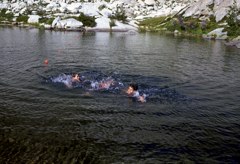 DESIGNATED SWIMMING AREA - 1968 DESIGNATED SWIMMING AREA - 1968 |
|
Art Brice says that Stan finally came up with a solution. “He simply created a portable waterfront program. We loaded floats, signage and life rings on the backs of burros and set off into the backcountry!” Camp got its “A” rating. “No inspector was going to hike 10 miles to see our program,” says Art. “They took our word for our dedication to the program.” After all, a Scout is trustworthy. “I think the sight of a white life ring dangling over the rump of a burro headed up the trail really impressed them.”
One of the very large Giant Sequoia trees on the Congress Trail in Giant Forest is named the Room Tree. The base of the tree has been burnt out leaving a large cavity in the standing, living tree. People have wandered into this “room” for decades, both on their own and as part of Ranger-Naturalist guided tours. In the mid 1960’s, one of the Ranger-Naturalists was bragging to his campfire audiences that he held the record for largest group of people to occupy the room at one time, thirty-five. The Staff at Wolverton took his claim as a challenge.
Each Sunday at camp, the Catholic Scouts and Leaders would head off to mass at Sunset Amphitheater in Giant Forest. LDS Troops would hold services at Beetle Rock. The Protestant Scouts and Leaders would attend services in camp (Jewish services were held on Friday evening) and then head to a meeting place, often the General Sherman Tree, to join the other members of their troops and embark on day hikes in the area.
One beautiful Sunday, all of the Scouts from Wolverton met and walked to the Room Tree. There, the Staff placed all of the Scouts in a single-file line and gave each one of them a number. The Scout at the front of the line was given the number one while the Scout at the end of the line wound up with a number greater than one hundred. (Yes, there were over a hundred Scouts in Camp that week. That actually was common in the 1960's.)
While Mike Robbins stood in the notch of the tree - the window about 10 feet up - holding his camera in position, the Scouts began to quickly fill the room. The first Scouts placed themselves with their backs against the interior wall. All of the Scouts were told to raise their arms above their heads so that they would take up less floor space. As the tree began to fill with Scouts, the aroma of a high school locker room wafted up to the window. Of course Camp Wolverton broke the NPS record and went on to pack 96 Scouts into the Room Tree before one of the leaders, a Psychiatrist, panicked. The Staff was hoping to break 100. Mike took a quick photo to record the event and then the Scouts were very happy to walk out.
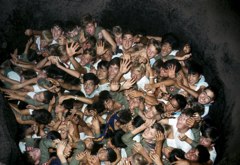 SCOUTS IN THE ROOM TREE SCOUTS IN THE ROOM TREE |
|
At the end of 1972, the Crescent Bay Area Council merged with the San Fernando Valley Council, and became the Great Western Council. In 1985, the name was changed to the Western Los Angeles County Council, and it still has that name today. The merging of the councils greatly and negatively affected Camp Wolverton, beginning with the summer of 1973, because San Fernando brought their Camp Whitsett with the merger.
Camp Whitsett is a nice, well run summer camp in the Southern Sierra. We have nothing negative to say about Camp Whitsett. Unfortunately for Wolverton, Camp Whitsett has more facilities, is about two hours closer to Los Angeles, and has pine trees surrounding a swimming lake too.
Many troops which previously went to Wolverton one year and Emerald Bay one year, now began choosing Whitsett instead of Wolverton. Also, those troops from San Fernando which previously went to Whitsett continued to go to Whitsett, not Wolverton. As a result, attendance began to drop at Wolverton. 1975 was the last summer the Council offered a full program at Camp Wolverton. That summer consisted of only two regular sessions. The staff, however, was there for two months!
Ranger Banquets
Once each season, on a Tuesday or Wednesday evening when the scouts and the packers were feasting on Bernard’s, Dri-Lite or Richmoor at one of the lakes, the rest of the staff would host a banquet for NPS employees and families. This was our opportunity to introduce ourselves and the camp to the people who we met on the trails, fixed our water system, collected our garbage and, most importantly, benevolently allowed the camp to exist. Our cook went all out in preparing a feast as the sample menu reveals. Meals at camp, in general, were a real treat for bachelor rangers and naturalists. In addition to the feast, we would take all those who were interested on a tour of the camp and often challenge them to a volleyball game.
Click on this link to see the menu of the 1971 Ranger Banquet.
Outpost Camp - 1976 to 2009
The summer of 1976 marked a new look for Camp Wolverton. The camp was no longer a full program summer camp, but instead, it was converted to an “outpost camp”.
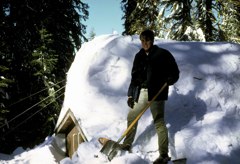 |
Winter Use |
The camp has never been officially used in the winter. This is because of the great snow fall which occurs. In extremely hard winters, the camp lodge building has been buried in snow. In the winter of 1968-69, the old shower house collapsed due to the weight of the snow. The shower house that is in camp today was built to replace the one that collapsed in winter 1968-69.
At the end of each summer, significant precautions are taken to reduce the damage predicted for the upcoming winter.
Over the years, some of the staff have unofficially used the camp for brief winter trips. We recently received a photo showing some of the original staff spending some time ice skating at Lodgepole during the winter of 1947-48. The lodge in Camp was just completed that summer, so it is likely they stayed there. Reportedly, some of the best new years have begun in the dark, snowy winter at Wolverton.
 A CAMPFIRE IN 1966
A CAMPFIRE IN 1966 DESIGNATED SWIMMING AREA - 1968
DESIGNATED SWIMMING AREA - 1968 SCOUTS IN THE ROOM TREE
SCOUTS IN THE ROOM TREE
